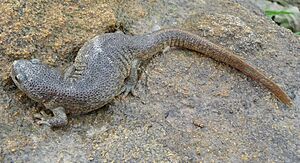Algerian ribbed newt facts for kids
Quick facts for kids Algerian ribbed newt |
|
|---|---|
 |
|
| Wild Pleurodeles nebulosus in Tunisia | |
| Conservation status | |
| Scientific classification | |
| Genus: |
Pleurodeles
|
| Species: |
nebulosus
|
The Algerian ribbed newt (Pleurodeles nebulosus) is a type of salamander. It belongs to the family Salamandridae. You can find this newt in the countries of Algeria and Tunisia.
These newts live in many wet places. Their homes include rivers, temporary rivers, swamps, and ponds. They also live in cisterns and freshwater marshes. Sadly, their homes are shrinking because of habitat destruction.
Discovering the Algerian Ribbed Newt
For a long time, scientists thought this newt was another species. It was often confused with Pleurodeles poireti. But in 2004, two scientists named Carranza and Wade studied them closely.
They found that most newts in North Africa that looked like P. poireti were actually Pleurodeles nebulosus. This showed they were a different species. The real P. poireti newts live only in a small area of northeast Algeria.
What Does the Algerian Ribbed Newt Look Like?
The Algerian ribbed newt is a medium-sized animal. It can grow to be about 23 centimeters (9 inches) long. Its head is flat, and it has small eyes. The front of its head, called the snout, is rounded.
The newt's body is also a bit flat. The male newt's tail is longer than the female's. When it's time to breed, both males and females grow fins on their tails. These fins are above and below the tail.
Its skin is usually olive-brown on top. It often has darker spots or patches. The sides of its body are yellowish. Its belly is a pale grey, sometimes with darker spots. The skin on its back feels very bumpy.
Protecting the Algerian Ribbed Newt
The Algerian ribbed newt lives in a specific area. This area is in northeastern Algeria and western Tunisia. They need freshwater places to live and have their babies. These places include marshes, ponds, streams, and cisterns.
This newt faces some challenges. Pollution in its water homes is a problem. Also, its habitat is being lost. This happens as more land is used for farming. More farm animals grazing can also harm their homes.
Even with these threats, the newt's situation is not too bad. The International Union for Conservation of Nature (IUCN) checks on animals. They have listed the Algerian ribbed newt as "least concern." This means it is not in immediate danger of disappearing.



